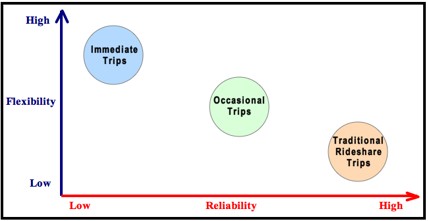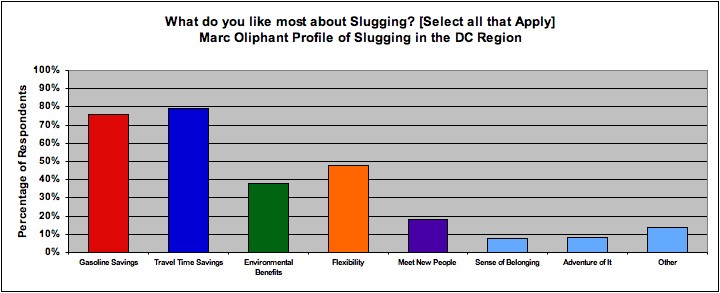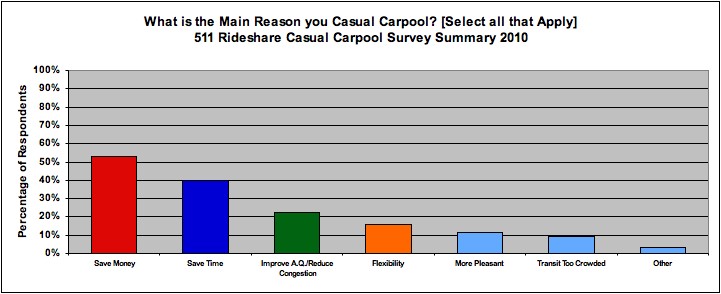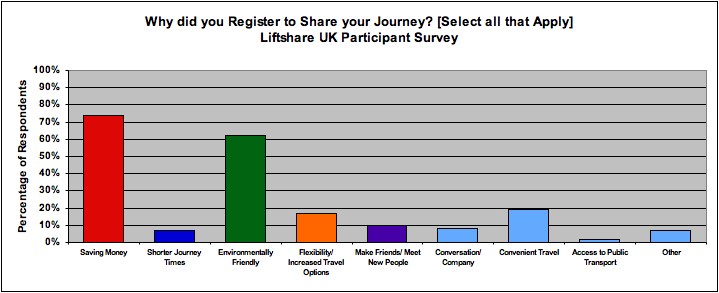Table of Contents:
- Definition & Technological Features of “Real-Time” Ridesharing
- Opportunities Created by “Real-Time” Ridesharing
- Drawbacks of “Real-Time” Ridesharing
- The “Real-Time” Ridesharing Value Proposition
Definition & Technological Features of “Real-Time” Ridesharing
Last modified on 2010-08-30 18:49:27 GMT.
“Real-time” ridesharing has been defined in a variety of ways. One of the first formal definitions proposed for “real-time” ridesharing was developed in preparation for a trial in Sacramento, CA in 1994 (Kowshik et al., 1996). The team behind that trial defined “real-time” ridesharing as “a one-time rideshare match obtained for a one-way trip either the same day or the evening before” (Kowshik et al., 1996). Several years later, researchers developing a similar trial in Seattle proposed that “dynamic ridesharing” be defined as “two or more people sharing a single trip, without regard to previous arrangements or history among the individuals involved…a dynamic ridesharing system must be able to match random trip requests at any time” (Dailey et al., 1997). A more recent definition proposed by ‘dynamicridesharing.org’ suggests that “dynamic ridesharing” is “a system that facilitates the ability of drivers and passengers to make one-time ride matches close to their departure time, with sufficient convenience and flexibility to be used on a daily basis” (Kirshner, 2009). Note that all three of the definitions emphasize the occasional nature of these arrangements, using the term “one-time” trips. The other main characteristic of all three of these definitions is the amount of advanced notice required for the arrangement of trips with the Sacramento definition recommending the “same day or the evening before” a trip, the Seattle definition recommending “at any time”, and the ‘dynamicridesharing.org’ definition recommending “close to [participants] departure time”. In general, “real-time” ridesharing implies that little advanced notice is needed when attempting to establish a shared trip.
For the purposes of the study presented in this paper, “real-time” ridesharing is defined as:
“A single, or recurring rideshare trip with no fixed schedule, organized on a one-time basis, with matching of participants occurring as little as a few minutes before departure or as far in advance as the evening before a trip is scheduled to take place”.
“Real-time” services tend to rely on a similar set of technologies and share similar features. The underlying technological requirements often include:
(1) Smart Phones – Many service designs rely on the recent proliferation of smart phones in the market place. The firms developing the underlying software for “real-time” ridesharing have focused their efforts on platforms with easy-to-use, attractive user interfaces such as Apple’s iPhone software and Google’s Android platform.
(2) Constant Network Connectivity – The need to communicate ride requests and accept offers on short notice requires that one be constantly connected to the network. Many smart phones are now offering (or require) unlimited data plans with new smart phone contracts, facilitating constant network connectivity.
(3) GPS Functionality – The use of Global Positioning System (GPS) functionality has been incorporated into many applications so that they become “location aware”. In other words, participants seeking a ride do not need to key in their current location because the GPS built into their smart phone knows where they are located and communicates this information automatically when trips are logged. This is often marketed as a time saving feature.
(4) Ride Matching Algorithm – All of the underlying systems use some form of algorithm to match riders and passengers. Some of the algorithms do so based only on origin and destination, while some of the newer algorithms match drivers and passengers based on the commonality of their travel route.
(5) Data Repository – All “real-time” systems (and Internet-connected rideshare systems in general) have a data repository where rideshare information is stored. The types of data stored might include a current list of ride requests and offers, individual participant profiles and summary statistics on participation.
Many (but not all) “real-time” rideshare services incorporate additional features such as:
(6) Stored User Profiles – Providers will allow users to create and save information profiles. Personal information such as name, employer, home and work locations, popular origin-destination (OD) pairs with the user’s preferred route, and a photo are common. Some systems require a photo of the driver’s vehicle and license number be provided. Stored profiles require more participant time on the front end, but make future ride requests much less time consuming.
(7) Social Network Integration – Because of the propensity of individuals to share rides with people they know or share common characteristics with, some providers have linked their services to existing social networks in an effort to improve successful matches. For some, this has meant incorporating their services with online networks such as ‘Facebook’. In these cases, only friends within a given individual’s immediate Facebook network will be considered when searching for ride matches. For other providers, ‘social network integration’ has focused on offering services to a specific organization or institution. In these cases, only co-workers at the same organization are considered as potential partners.
(8) Participant Evaluation – “Real-time” services may allow participants to rate each other, much like the online auction service ‘eBay’. After a ride has been completed successfully, both the passenger and driver are asked to rate each other. The idea behind this feature is that it allows future users to evaluate potential partners quickly, based on others past experiences. The theory is that those with higher ratings are likely to be preferable shared ride partners.
(9) Automated Financial Transactions – “Real-time” services may allow for financial transactions between participants. Some allow participants to name their own price, while others recommend a value based on standard Internal Revenue Service (IRS) vehicle cost estimates. Some providers facilitate automatic transactions through the use of online payment systems such as PayPal. Other providers simply calculate the recommended shared cost and allow drivers and passengers to negotiate and agree on a final amount and payment method.
(10) Incentives and Loyalty Rewards Linked to Participation – “Real-time” providers may offer incentives or loyalty rewards based on a given individual’s level of participation, much like airline loyalty programs. Those that participate more frequently earn more points or rewards. Providers hope that by providing incentives, existing participants will be encouraged to post rides more frequently, and new participants will be encouraged to join their service.
Opportunities Created by “Real-Time” Services
Last modified on 2010-08-30 19:17:02 GMT.
The benefits of “real-time” ridesharing are numerous, and begin to address a number of the challenges that hinder greater rideshare participation. The most substantial benefit is an expansion in the types of vehicle trip that are suitable for ridesharing. This added trip flexibility is a distinct advantage for “real-time” rideshare participants.
Expansion of Trip Types Suitable for Ridesharing
Traditional rideshare arrangements often involve recurring trips that are relatively fixed in terms of schedule, take place for months at a time and are generally agreed to a day or two ahead of time. In contrast, “real-time” services are often marketed as allowing users to find ‘immediate’ single trips on very short notice, perhaps as little as 30 minutes ahead of time. This raises an important question about the desirability of these ‘immediate’ trips. Is this type of rideshare offering perceived as valuable to potential participants? A study found that of sixty focus group participants, less than a handful were interested in arranging ‘immediate’ rides (Deakin, Frick, Shively, 2010). They felt that these “instant” trips would be difficult to arrange or simply would not work. Rather, participants were interested in arranging rides on a part time or occasional basis with notification of potential trips well in advance, such as the evening before their commute to work. Deakin, Frick & Shively used the term “reliable flexibility” to describe this participant need. However, a recent survey conducted in the San Francisco Bay Area suggests that rideshare participants are a heterogeneous group (Heinrich, 2010). When asked how far ahead of time participants would like to organize a shared ride, 43% desired organizing their ride 15-60 minutes before departure, or on very short notice. The second most popular response was to organize a trip the evening before it was expected to take place (20% of respondents), supporting to a certain degree the preferences uncovered by Deakin, Frick & Shively.
Based on these important insights, “real-time” ridesharing services could cater to three unique types of rideshare trip; immediate trips, occasional trips with advanced confirmation, and traditional, long-term rideshare trips.
Immediate trips, where a passenger seeks a ride on very short notice, might be undertaken when they have found themselves with few transport alternatives. Perhaps the passenger has missed a transit trip or their original rideshare opportunity fell through at the last minute. In this case, trip flexibility is very high, but the reliability of successfully organizing this type of trip is fairly low.
Occasional rideshare trips are likely to occur among commuters that would like to share rides, but have social schedules that change week to week, or work inconsistent hours. In these situations, participants would prefer to establish rideshare arrangements on a day-by-day, or ride-by-ride basis. Ideally, a “real-time” service would send a note to all participants that have identified themselves as looking for occasional rideshare trips at an established point, say 5pm weekday evenings. Participants would have several hours to confirm their desire to share a ride and their desired travel time. At a certain point, say 7pm, no further ride requests would be accepted for the following morning and matching would take place immediately. Several minutes after 7pm, participants that could not be matched would be notified and alternate travel options would be outlined. For those participants that could be matched, the trip details of the appropriate travel partner would be sent and both participants would have a short period of time to review the trip and confirm their intention to ride with that individual. A similar process would take place around midday for the evening commuting trip. These occasional arrangements provide participants with greater schedule flexibility than traditional ridesharing while providing greater reliability than immediate rideshare opportunities.
Traditional rideshare arrangements, whereby drivers and passengers with similar and rather fixed schedules agree to share rides for a longer period of time, can also be provided by “real-time” rideshare services. In these instances, the importance of the personal characteristics of the driver and passenger are more important than the speed of matching. The reliability of the trip is generally high, but trip flexibility is low.
Decreases Transaction Costs
Rideshare services, specifically those with smart phone functionality that actively contact participants with potential matches, can significantly reduce the amount of time needed to establish a rideshare arrangement. The automatic accessing of profile information remotely, including a participant’s current location, minimizes the amount of direct user input needed. Decreasing these “transaction costs” (time needed to establish a rideshare trip) sometimes comes at the expense of a rigorous review of the profiles of potential rideshare partners. Some providers have attempted to overcome this perceived drawback by providing participant ratings that allow users to quickly determine how previous partners have perceived riding with a given person.
Improves Information Availability for Traveler Decision Making
Some “real-time” rideshare services integrate information from other modes of transportation in addition to rideshare options. In the event that a rideshare match cannot be established, transit or shuttle bus information can be provided to users allowing them to make more informed travel decisions.
Reduces “Stranger Danger” Concerns
While some features of “real-time” rideshare services may actually increase “stranger danger” concerns (such as the automatic matching of drivers and passengers), many services have incorporated features that reduce “stranger danger”. Many services work on mobile devices with GPS that theoretically should be able to track each participant’s position throughout a rideshare trip. If a participant agreed to share this type of information with a rideshare provider, it could be used to track participants and ensure that the agreed upon journey is taking place, and it could be used to validate that a successful shared ride was undertaken for those journeys where a financial transaction was agreed to, or where incentives are being disbursed. If this feature is coupled with ‘social network’ features (such as only allowing shared rides between employees within the same firm), ‘stranger danger’ concerns can be further mitigated.
Drawbacks of “Real-Time” Services
Last modified on 2010-08-30 19:33:23 GMT.
The drawbacks of “real-time” ridesharing are a series of trade-offs. While “real-time” innovations can offer greater flexibility and can provide valuable travel data, those benefits need to be balanced against reductions in travel reliability and a loss of privacy.
Flexibility vs. Reliability Trade-Off
A large trade-off involved in the use of “real-time” ridesharing is the loss of trip reliability in exchange for trip flexibility. However, the degree to which these two features are traded-off depends on the type of rideshare trip being sought. While traditional rideshare opportunities suffer from a lack of flexibility, they are quite reliable. On the opposite end of the spectrum, immediate rideshare trips are very flexible, but provide little service reliability. Occasional trips, where matching takes place sufficiently far in advance of the start of the trip to allow for alternate travel arrangements to be made, tends to offer a balance between flexibility and reliability.
Valuable Travel Data vs. Loss of Privacy
“Real-time” rideshare services operating on smart phones with integrated GPS have the ability to generate much more valuable data than simple rideshare trip confirmation. If data were to be collected throughout the day, detailed travel patterns including the prevalence of trip chaining could be determined. From an urban planning and transport modeling perspective, this information could be used to supplement periodic travel diaries and improve the input data used in urban modeling endeavors. With a sufficiently large number of these devices collecting data, traffic patterns and congestion information could be inferred. This information could be quite valuable to public agencies or rideshare providers themselves, however all of these examples of data collection involve a loss of personal privacy for the user of the smart phone. A fundamental challenge with future use of “real-time” rideshare services will be balancing the use of technology for innovative data gathering, while ensuring that personal privacy is respected.
The “Real-Time” Value Proposition
Last modified on 2010-09-13 15:55:29 GMT.
“Real-Time” services effectively expand the number of vehicle trip types that are suitable for ridesharing, thereby allowing greater travel flexibility. It allows drivers and passengers to choose the degree of flexibility and trip reliability based on their needs. Instantaneous trips provide high flexibility, but lower reliability. Traditional, pre-planned rideshare arrangements are quite reliable, but less flexible. Occasional trips provide some combination of the two.

However, it is important to note that in existing, successful rideshare schemes, flexibility is often ranked as less important than economic benefits such as transportation cost savings (gasoline, parking) and travel time savings. In recent surveys of successful, self-organized rideshare services in Washington DC and San Francisco, flexibility ranks 3rd and 4th, respectively, in terms of importance to participants. In a 2008 survey of pre-arranged shared rides in the UK, flexibility remained the third most important consideration behind cost savings and environmental benefits. With this in mind, one must ask whether “real-time” service innovations alone are sufficient to increase participation? The research team’s belief is that improvements in rideshare services, namely “real-time” innovations, need to be paired with financial and/or convenience incentives in order to successfully attract new participants. “Real-time” rideshare trials in a variety of locations, with a variety of incentive packages will begin to provide more information on the relative value of “real-time” services.


